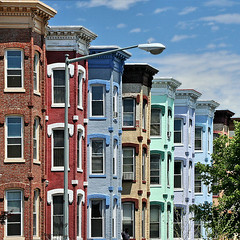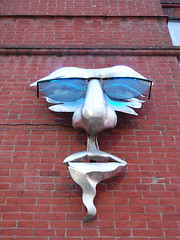Unofficial Washington: how architecture shapes the real city

Posted November 24, 2008 at 1:55PM
As a longtime and very committed resident of DC, I often barely recognize the place that the media are talking about when they comment on "Washington." To listen to them, we are all about politics - not even policy, just politics - and power struggles among self-important people. We are characterized as politics just as Hollywood is characterized as movie-making, Broadway is characterized as musicals, and Detroit is simplified as car manufacturing.
The architecture of politics, of course, is the Capitol Building, the White House and, occasionally, the Supreme Court building. Preferably with the Washington Monument visible in the background. I'm always amused when TV reporters set up with the Capitol or White House in the background when there is nothing actually happening there at the time; the viewer would miss none of the story if it were simply delivered from the studio.
 You know where I'm headed. Official "Washington" has very little to do with the city that I live in. I don't lobby (though I did for a few years) and have only been in the White House and Supreme Court once each on business. Now, I do enjoy our wonderful public museums, one of the Obama daughters will be going to school a stone's throw from my house, and my wife works for a federal agency (in Alexandria, though, not in DC). NRDC is certainly populated with a significant number of people who lobby and do it well. But I am personally affected much more by unofficial Washington - my wife's family has lived here for generations and her brother works in real estate, not politics; I went to a basketball game Saturday, like thousands of fans all over America; and I much prefer neighborhood walks and bistros to the major monuments.
You know where I'm headed. Official "Washington" has very little to do with the city that I live in. I don't lobby (though I did for a few years) and have only been in the White House and Supreme Court once each on business. Now, I do enjoy our wonderful public museums, one of the Obama daughters will be going to school a stone's throw from my house, and my wife works for a federal agency (in Alexandria, though, not in DC). NRDC is certainly populated with a significant number of people who lobby and do it well. But I am personally affected much more by unofficial Washington - my wife's family has lived here for generations and her brother works in real estate, not politics; I went to a basketball game Saturday, like thousands of fans all over America; and I much prefer neighborhood walks and bistros to the major monuments.
 The architecture of my city is not about white marble but red brick, mostly, either in the natural color or painted. It's typically 3-5 stories high. And it is the subject of a story in Dwell by Aaron Britt, who interviewed Martin Moeller, senior vice president and curator at the National Building Museum and another longtime Washingtonian. Moeller, who lives in the Logan Circle neighborhood (above and left) responds to a question about "the most important building in DC":
The architecture of my city is not about white marble but red brick, mostly, either in the natural color or painted. It's typically 3-5 stories high. And it is the subject of a story in Dwell by Aaron Britt, who interviewed Martin Moeller, senior vice president and curator at the National Building Museum and another longtime Washingtonian. Moeller, who lives in the Logan Circle neighborhood (above and left) responds to a question about "the most important building in DC":
"I always talk about the row houses. To a trained eye you can see that's a Logan Circle row house, or that's a Georgetown or a Columbia Heights row house. We have three or four distinct styles here and their scale is what makes them so special. The row house neighborhoods of Washington are so successful because they have lots of doors to the street. There's this implicit mingling of public and private spaces along the sidewalks. Particularly with the bay windows that face the street here, usually right next to the front doors. The facades are flat in many of the row houses of, say, Philly or Baltimore, but in DC you have an irregular streetscape, with stoops and little yards."
 Discussing walkability, Moeller adds:
Discussing walkability, Moeller adds:
"The typical visitor to Washington spends most of his or her time in highly ordered, controlled environments like the National Mall or Capitol Hill, while missing the diverse neighborhoods, lesser-known cultural institutions, and quirky local landmarks that punctuate the daily lives of residents. There are, for instance, an otherwise unremarkable couple of blocks of Corcoran Street NW that are peppered with delightful small metal sculptures-some freestanding in front gardens, others affixed to doors and facades-all by one artist who used to live on that street [see photo immediately above]. To me, these modest works of art are as quintessentially Washingtonian as the Lincoln Memorial."
 There's much more in the article, of course. I was particularly pleased that Moeller defends the city's building height restrictions, which some advocates think should be lifted to allow more downtown density. I'm for density, too, but not particularly on the scale of New York or Hong Kong, China. My friend Hank Dittmar, who heads The Prince's Foundation in the UK, says their research indicates that some of the densest parts of London, a city that works incredibly well, actually are the ones with six-story buildings, well below DC's height limit. Moeller notes that DC is always rated highly walkable, and believes that the consistency of our downtown density and our manageable scale are major contributors to that.
There's much more in the article, of course. I was particularly pleased that Moeller defends the city's building height restrictions, which some advocates think should be lifted to allow more downtown density. I'm for density, too, but not particularly on the scale of New York or Hong Kong, China. My friend Hank Dittmar, who heads The Prince's Foundation in the UK, says their research indicates that some of the densest parts of London, a city that works incredibly well, actually are the ones with six-story buildings, well below DC's height limit. Moeller notes that DC is always rated highly walkable, and believes that the consistency of our downtown density and our manageable scale are major contributors to that.
Kudos to Moeller, Britt, and Dwell for the nod to us locals. Now if they could only get us representation in Congress.
Related post:
New online guide highlights the (sometimes hidden) beauty of Washington, DC (September 24, 2012)